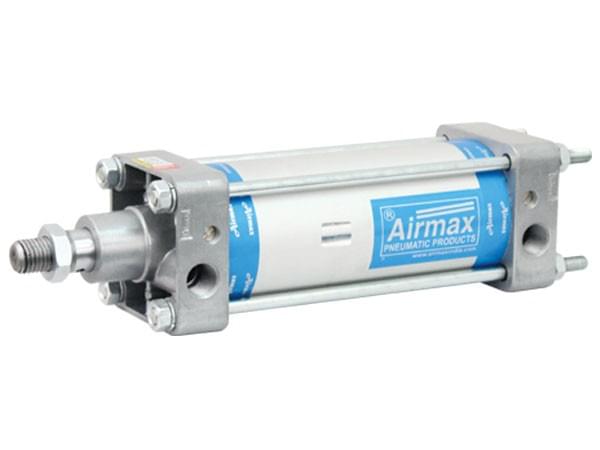A Pneumatic Cylinder is a mechanical gadget that takes the force of packed air to deliver power and movement, in a direct design. Pneumatic cylinders can be separated into different kinds. There are cylinders with cylinder poles, bar-less cylinders, turn cylinders, couple and multi-position cylinders, plug cylinders, cinching cylinders, drives with a direct aide, and cries and stomach cylinders.
The most widely recognized and notable out of the above expressed pneumatic cylinders will be cylinders with cylinder bars. The two most normal cylinders with cylinder poles are single-acting cylinders (SAC) and twofold-acting cylinders (DAC). Both offer comparable cosmetics; the cylinder barrel, bearing cap, end cap, cylinder, and cylinder bar are the key parts that make up both a SAC and DAC. A pneumatic cylinder isn't comprised of just those 5 sections. There are seals, course, directing groups, long-lasting magnets, and some more, however, these five as I expressed are the KEY parts.
Cylinder barrels were initially tubes on pneumatic cylinders. Today the cylinder barrels have adjusted to an expelled profile rather than a cylinder. Adjusting to this expelled profile gives the pneumatic cylinder one major benefit. The capacity to mount more sensors and connection parts. For instance, mounting a brace or jaw would permit the pneumatic cylinder the capacity to pick and place objects.
Doing the development of the cylinder pole and shaping seals between the front and back cylinder is every one of the elements of the cylinder. Seen as connected to the cylinder is the cylinder bar. Its motivation is to send the power and development of the cylinder to the outside. This is likewise the part to which a connection can be mounted.
Alongside the cylinder, bearing covers end up with different obligations. They close the cylinder barrel, are the hotspot for an air association, and structure a direction and fixing point for the cylinder bar. The bearing cap is associated with the opening of the cylinder. Along these lines, there must be something that assists it with shutting. That is the very thing that the end cap is for. Situated on the contrary side, the end cap shuts the cylinder.
What do pneumatic cylinders truly do and how would they function? A blower sends compacted air into a hole toward one side of the cylinder. As that compacted air enters the hole, the cylinder is compelled to move the cylinder bar to carry out its ideal role. Contingent on whether your pneumatic cylinder is SAC or DAC, your cylinder bar can fall once more into position by delivering the air normally and a spring specialist supporting its re-visitation of position, or a directional valve can switch and direct air into one more hole at the furthest edge of the cylinder. That is which isolates a SAC from a DAC; how the cylinder pole is controlled. The single-acting cylinder is the one where the cylinder pole gets back to its unique situation by normally delivering the air and permitting a spring repairman to help it to the position. The explanation it must be done this way is because the SAC just has one packed air association. Through one solenoid valve, compacted air is squeezed into the rear of the cylinder. Looking for the most straightforward method for getting away, the compacted air applies a lot of power to the substance of the cylinder. The power of the essence of the cylinder makes the cylinder pole carry out its role. After the capabilities are played out, the administrator CAREFULLY lets the air out of the depression which permits the spring to help the cylinder bar once again into its beginning position.

Single-acting pneumatic cylinder enjoys their benefits. Characterized position in case of a power disappointment, decreased air utilization, and simple incitation using a 3/2-way valve are the most widely recognized benefits. Be that as it may, with its benefits comes to its burdens. The cylinder has a more extended development length, spring-subordinate stroke length restricts the most extreme stroke length, force is just developed in one heading, force is decreased by the spring power, and there is no steady power. These disservices are the reason most clients track down the twofold acting cylinders the better of the two cylinders.
Twofold-acting cylinders use valves to infuse two different exchanging floods of compacted air. These two rotating air streams consider the power to be conveyed in a propelling house and retracting estate. Similarly, as the SAC works at the outset so does the DAC. The DAC sends compacted air into one cavity through a directional valve. This compacted air makes the cylinder bar carry out its role. Presently the distinction becomes possibly the most important factor. Rather than delivering the air to withdraw the cylinder pole, a directional valve switches the packed air into one more cavity at the far edge. This takes into account a more straightforward withdrawal of the cylinder pole.
Benefits of a DAC; they can keep up a steady power, power can be developed in the two headings, and its strokes have a few meter prospects. Destructions are not many yet critical to note. More packed air will be required because of more incessant and strong development occurring. The DAC has no characterized position, not at all like the SAC, which could thusly cost you in case of packed air disappointment.
There is a general justification behind the insight that the DAC is more important. This is because each benefit SACs have over DACs is a result of the SAC's ruin. This could appear to be a piece confounding yet here's a clarification. The SAC can remain in one characterized position and the DAC has no characterized position. Be that as it may, the justification for this is because the SAC just moves in a single heading while the DAC moves in the two bearings. Airmax Pneumatics Ltd is the leading Pneumatic Cylinder Manufacturers in India.